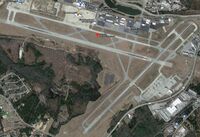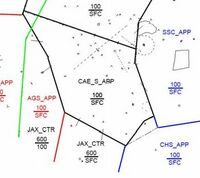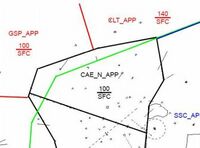Columbia Metro ATCT/TRACON: Difference between revisions
| Line 120: | Line 120: | ||
<br> | <br> | ||
All VFR remaining in the pattern will require coordination with the tower and will be directed to contact when ready for taxi. | All VFR remaining in the pattern will require coordination with the tower and will be directed to contact when ready for taxi. | ||
</tab> | </tab> | ||
<tab name="Departure Frequency"> | <tab name="Departure Frequency"> | ||
Revision as of 11:58, 5 June 2023
Table of Updates
| Date | Revision | Items Revised |
|---|---|---|
| 2 May 2023 | A | Update of Organization |
Area Information
| ICAO Code | Airport Name | Airspace | IFR Beacon Codes | VFR Beacon Codes |
|---|---|---|---|---|
| KCAE | Columbia Metro Airport | C | 1601-1677 | 1601-1677 |
| Purpose This document prescribes the procedures to be utilized for providing air traffic control services at the Columbia Metro Air Traffic Control Tower (CAE ATCT) and TRACON. The procedures described herein are supplemental to the Jacksonville ARTCC Facility Operating Guidelines and FAA Order JO 7110.65, as well as any published FAA guidelines or procedures. Distribution |
Operational Positions
| Position | Radio Name | Callsign | Relief Callsign | Symbol | Frequency |
|---|---|---|---|---|---|
| Clearance Delivery | Columbia Clearance Delivery | CAE_DEL | CAE_1_DEL | 7CD | 119.750 |
| Ground | Columbia Ground | CAE_GND | CAE_1_GND | 7CG | 121.900 |
| Tower | Columbia Tower | CAE_TWR | CAE_1_TWR | 7CT | 119.500 |
| Position | Sector Name | Callsign | Relief Callsign | Symbol | Frequency |
|---|---|---|---|---|---|
| RN | Radar North | CAE_N_APP | CAE_1N_APP | 7RN | 133.400 |
| RS | Radar South | CAE_S_APP | CAE_1S_APP | 7RS | 124.150 |
| RF | Radar Final | CAE_F_APP | CAE_1F_APP | 7RF | 128.500 |
Sector in Red is the primary sector.
Clearance Delivery
Initial Altitude for all IFR Departures is 4,000 feet. Pilots shall expect their cruise (if higher) in 10 minutes after departure.
There is no published departure procedures for Columbia. All aircraft will be cleared to their destination via radar vectors to their first fix.
Phraseology
{Callsign}, You are cleared to the {Arrival Airport} Airport via radar vectors {First fix} then as filed. Maintain 4,000, expect {cruise} one-zero minutes after departure. Departure Frequency {departure frequency}, squawk {squawk code}.
VFR with or without flight following maintain VFR at or below 2,000 feet.
Columbia Metro is a class Charlie. All VFR traffic not remaining in the pattern will be issued a discrete squawk code.
Phraseology
{Callsign}, Maintain VFR at or below 2,000 feet, {departure frequency}, squawk {squawk code}.
All VFR remaining in the pattern will require coordination with the tower and will be directed to contact when ready for taxi.
The table below list the common frequencies used a departures frequencies by CAE Clearance Delivery. This guide is only that, a guide. The actual departure frequency has to determined based on coordination with the other controllers that are online.
| Position | Callsign | Traffic Direction | Symbol | Frequency |
|---|---|---|---|---|
| Radar South | CAE_S_APP | South | 7RS | 124.150 |
| Radar North | CAE_N_APP | North | 7RN | 133.400 |
Ground
Ground Control does not authorize pushbacks or startups unless the aircraft pushing will enter the controlled area during the pushback.
Phraseology
Aircraft does not enter the controlled area
{Callsign}, Push back and start is at your discretion.
Aircraft does enter the controlled area
{Callsign}, Push and start approved, push tail facing (direction)
As the taxiways at Columbia Metro are simple, there are no defined routes for taxi.
Phraseology
To Runway
{Callsign}, Runway {Number} taxi via {taxi instructions} {Any Hold Short Instructions}.
To Ramp
{Callsign}, Taxi to the ramp via {taxi instructions} {Any Hold Short Instructions}.
Ground Control must advise Local Control of all intersection departures verbally or through the chatbox in the controller client.
Phraseology
{Callsign}, Runway {Runway Number} at {Intersecting Taxiway}, taxi via {taxiways} {Any Hold Short Instructions}.
Ground controller shall ensure each pilot has the current ATIS information prior to being handed off to Local Control
GC must transfer communications to LC if an aircraft is to operate on an active runway.
Phraseology
{Your Callsign}, {Their Callsign} (wait for response)
One to cross runway {number} at {Taxiway} (wait for response)
If Approved: Approved {Their OI} Response: Approved {Your OI}
If Denied: Hold {reason}
Once Crossing Completed: {Your Callsign}, {Their Callsign} (wait for response)
Crossing Complete {Your OI}, Roger {Their OI}
GC shall instruct aircraft to contact tower unless otherwise agreed upon by LC. LC can request pilot monitor the frequency instead of contacting.
Phraseology
{Callsign}, Contact Columbia Tower 119.5
Tower
LC has responsibility for a five mile radius from the CAE field from surface up to and including 2,500 feet. LC has responsibility to control 4,000 feet and below 1 ½ miles either side of the extended centerline within 5 miles of the departure end of the automatic departure runways.
The active runway shall be determined based on wind and known
factors that may affect the safety of takeoff/landing operations.
Runway 11 is designated as the calm wind runway.
7110.65Z Runway Selection
LC will provide separation for aircraft in the LC airspace.
LC shall provide initial radar separation between successive departures.
When automatic departures are in effect, IFR jet/turbojet departures
shall be released on runway heading climbing to 4,000 feet.
LC has the option to assign all NON-JET aicraft runway heading or a fanned heading that will conform to the applicable departure corridor.
Phraseology
{Callsign}, {Departure Instruction}, Wind {direction} at {speed}, Runway {Runway}, Cleared for takeoff
{Callsign}, Contact Departure {frequency}
LC shall be responsible for separation of all arrival aircraft that have
been handed off by TRACON from all departing aircraft still under LC
jurisdiction
Phraseology
{Callsign}, {Traffic Advisories} , Wind {direction} at {speed}, Runway {Runway}, Cleared for land
Practice Instrument Approaches: Issue special instructions as verbally coordinated with the
TRACON. Practice Instrument Approaches shall assign runway heading and maintain 4,000 feet. Departure frequency as assigned by approach control.
Phraseology
{Callsign}, Fly Runway Heading, Climb and Maintain 4,000, Contact Approach on {Frequency}
LC shall NOT change the approach sequence without coordination. Communication transfer must be completed prior to five nautical miles
from the runway.
LC shall assign IFR aircraft runway heading and 4,000 feet
LC must verbally coordinate with departure prior to frequency change.
Phraseology
AFTER COORDINATION WITH TRACON: {Callsign}, Fly {Heading}, Climb and Maintain {Altitude}, Contact Approach on {Frequency}
LC is authorized automatic releases from the TRACON controller so long as the aircraft departs on the pre-coordinated active departing runway(s) on approved departure headings
In order for automatic releases to be authorized, procedures in this document shall be followed.
Departure releases must be obtained if automatic releases are suspended by TRACON.
Phraseology
Requesting Release: {Their Callsign}{Your Callsign},
(Hold for answer)
Release for departure, {Airport} {Callsign} {Runway} {First Fix}
(Hold for Answer)
If Approved: Approved{Any Restrictions} {Their OI} Roger, Approved {Restrictions} {Your OI}
If Denied: Hold; Expect clearance at {Zulu} {Their OI} Roger {Your OI}
Columbia Metro ATCT is a visual/VFR tower and shall not initiate or accept any radar handoffs and shall not initiate control/start track on any target.
LC shall manage the ATIS for KCAE
The ATIS shall be on 120.150
TRACON Information
| RS (CAE_S_APP) is the primary "combined" radar position for Columbia Metro Tracon. No other sectors shall be staffed until the "combined" position is in use. RS may delegate a portion of its airspace to RN. One RS and RN are staffed, they both can delegate a portion of their airspace to RF
|
| RN (CAE_N_APP) is the secondary radar position for Columbia Tracon. RS may delegate a portion of its airspace to RN.
|
RN and RS may delegate a portion of their airspaces to RF, once both are in use.
RF area of jurisdiction is from the arrival end of the selected arrival runway to a 20nm radius for 10nm on either side of the selected arrival runway, from surface to 4,000 feet MSL. RF is responsible for sequencing arrival aircraft.
VFR Aircraft entering the Class Charlie airspace will be given a discrete beacon code.
Phraseology
{Callsign}, squawk {squawk code}.
If an aircraft departs from CAE and does not request a flight following, the aircraft will be handed off from LC to TRACON and released to UNICOM once clear of the Class Charlie.
Phraseology
{Callsign}, Change to Advisory Frequency Approved, squawk 1200.
7110.65Z Class C Service- Terminal
Columbia Metro ATCT is a VFR tower. No radar handoffs shall be initiated to LC.
TRACON controllers shall not drop the track on any arriving aircraft. This allows a controller to maintain radar identification during missed approach.
Phraseology
{Callsign}, Contact Columbia Tower on {frequency}.
TRACON sectors give automatic releases to all departures from Colubia ATCT when departures follow the standard departure procedures as specified in this document.
All other airports within TRACON’s boundaries shall request a departure release. Upon approval of the release, the release shall be good for five minutes.
Upon issuance of the takeoff clearance, a departure message shall be sent to the appropriate departure sector. This can be accomplished non-verbally by the LC ensuring the aircraft is squawking the appropriate squawk code and mode C is enabled when airborne.
Phraseology
Requesting Release: {Their Callsign}{Your Callsign},
(Hold for answer)
Release for departure, {Airport} {Callsign} {Runway} {First Fix}
(Hold for Answer)
If Approved: Approved{Any Restrictions} {Their OI} Roger, Approved {Restrictions} {Your OI}
If Denied: Hold; Expect clearance at {Zulu} {Their OI} Roger {Your OI}
Forward departure instructions to LC for aircraft executing practice missed approaches.
Ensure all departures are on course as soon as practical.
All departures should be on course before handoff to Enroute Control unless otherwise coordinated. Aircraft shall be climbed to 10,000 or less if filed.
Provide airspace for automatic departures and radar final.
Provide airspace for missed approach on all runways.
The sector responsible for the primary runway shall establish the approach sequence for all arrivals.
Communications transfer of arriving aircraft to LC must be accomplished no later than five nautical miles from the end of the arrival runway.
When simultaneous approaches are being conducted on converging runways, LC is responsible for ensuring runway separation. However, TRACON must provide enough spacing to minimize the possibility of a go-around.
When vectoring to final from parallel downwinds, aircraft on opposing base legs shall be assigned altitudes to ensure vertical separation unless other approved separation has been applied. This ensures separation in the event of an overshoot on final.
Coordinate with LC for any aircraft conducting approaches to other runways than the active arrival runway(s) in use.


